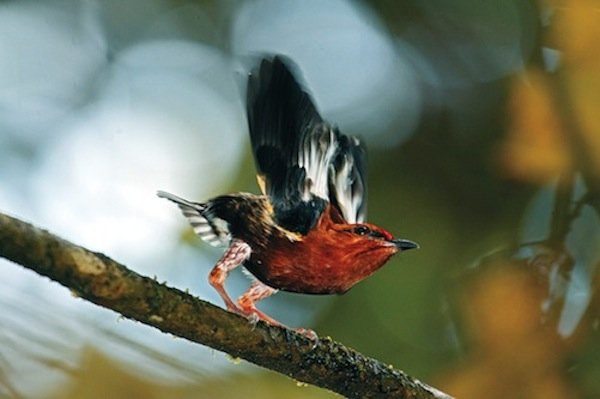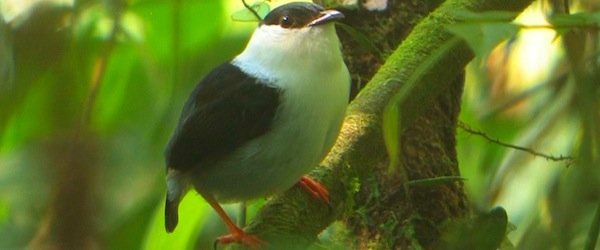What’s the deal with manakins? Are they for real? These are just a few of the questions that come to mind when watching these bizarre little birds. On a recent filming trip with Tropical Birding in Ecuador I had the awesome experience of getting up close and personal with two bizarre manakin species. Most manakins are a mixture of Fred Astaire, Tweety Bird and Mozart in that they have the admirable talents of dance, adorable plush-toy cuteness and music that combine to produce some of the most staggering mating displays in the bird world.
Take the Club-winged Manakin for example. This bird is a Choco endemic found only in northwest Ecuador and southwest Colombia. Out of all the crazy manakin displays, the Club-winged Manakin indisputably has the most advanced sound display. Specially adapted violin-like feathers allow it to produce an incredible “tick-tick-ting” sound that is irresistible to the female of the species. For many years it was unknown exactly how the feather structure worked and even today there is some debate as to the exact mechanics of it. The best explanation comes from observations of slowed-down high speed video by researcher Kimberly Bostwick.
 A displaying male Club-winged Manakin by Nick Athanas
A displaying male Club-winged Manakin by Nick Athanas
She describes the manufacture of this sound as follows. “I recorded males making this sound in the Ecuadorian Andes using a digital high-speed video camera. By examining the video at slower speeds, I could see that the males were knocking a pair of modified wing feathers together over their back at a very high rate–more than 100 cycles per second–twice as fast as an average hummingbird flaps its wings. Although the video showed feathers knocking together, the sound the bird made was a tone. Further, the sound produced by these knocking feathers was approximately 14 times faster than the rate of the knocking itself.”
Reviewing the video footage alone was not enough for Kimberly to exactly know how the “ting” sound is produced so she started closely examining the feathers of Club-winged Manakins. What she found was astounding. The club-shaped hollow wing feathers that the manakins knock together with other specially modified feathers each have seven tiny ridges on them. Other feathers situated in close proximity to the club-shaped feathers have a kink in them, equivalent to the bow of a violin perhaps. Combining the video evidence with the feather evidence she came up with the following conclusion.”The Club-winged Manakin is a bird with a pair of violins built into its wings. The wide, ridged feathers form the body of the violin and the thin, kinked feathers next to them forms the bow. When male manakins knock their wings together across their backs over and over again in a rapid cycle, the momentum from the heavier-than-usual feather shafts causes the bow feather to slide first inward across the ridged feather, then outward. This generates friction and vibration. The seven ridges generate seven knocks on the way in and seven on the way out, which adds up to that frequency multiplier of 14 needed to explain the discrepancy between the rate of feather knocking and the frequency of the sound heard. The fat hollow feather resonates at this stimulated frequency, and out comes the unique sound of the Club-winged Manakin.” How in the world does such a tiny bird come up with such a complicated and intricate musical system? Yet another of the fascinating and mind-blowing examples of the wonders of the avian world.
After filming the unique lekking behavior of the Club-wingeds we headed off to search for another manakin that uses sound as an important part of its lekking display, the White-bearded Manakin.
 A displaying male White-bearded Manakin
A displaying male White-bearded Manakin
If Club-winged Manakins are the violinists of the manakin world, then the White-bearded Manakins are the fire-starters. The males produce a high-energy, fast-paced hopping dance, accompanied by a “Chee-poo” call and firecracker-like snaps of their wings to entice the drably colored females. I struggle to describe how weird it is to be surrounded by dozens of these displaying birds. Suffice to say that it is like being at a mini July 4th celebration in the rainforest. Random cracks, sizzles and whirs emanate from the impenetrable sea of green but the birds themselves are very tough to observe. As with much birding this is where patience comes in and its best to go to the last location of a crack and sit and wait. We were lucky to observe the entire display several times only about 10 feet from us. A further example of the stunning and enchanting world of manakins.
Our full video on these amazing birds can be viewed below…
httpv://www.youtube.com/watch?v=hEUr01attXs













Great video — certainly got me excited. I’ll be there in a few weeks and this has given me some excellent insights. Thanks!
Awesome video! Yes, what is it with manakins? They are like living, plush feathered, wind-up toys that do funny dances. How cool is that?
@Pete – Enjoy it! Great country.
@Patrick. Yes, it’s like each species has its own full-on personality.